What do we know about New Zealand’s mangroves? Not nearly as much as we know about our forests and many other habitats. Their changing tidal environment makes mangroves a difficult location for research and perhaps we just don’t care about our mangroves as much as we do about our forest trees.
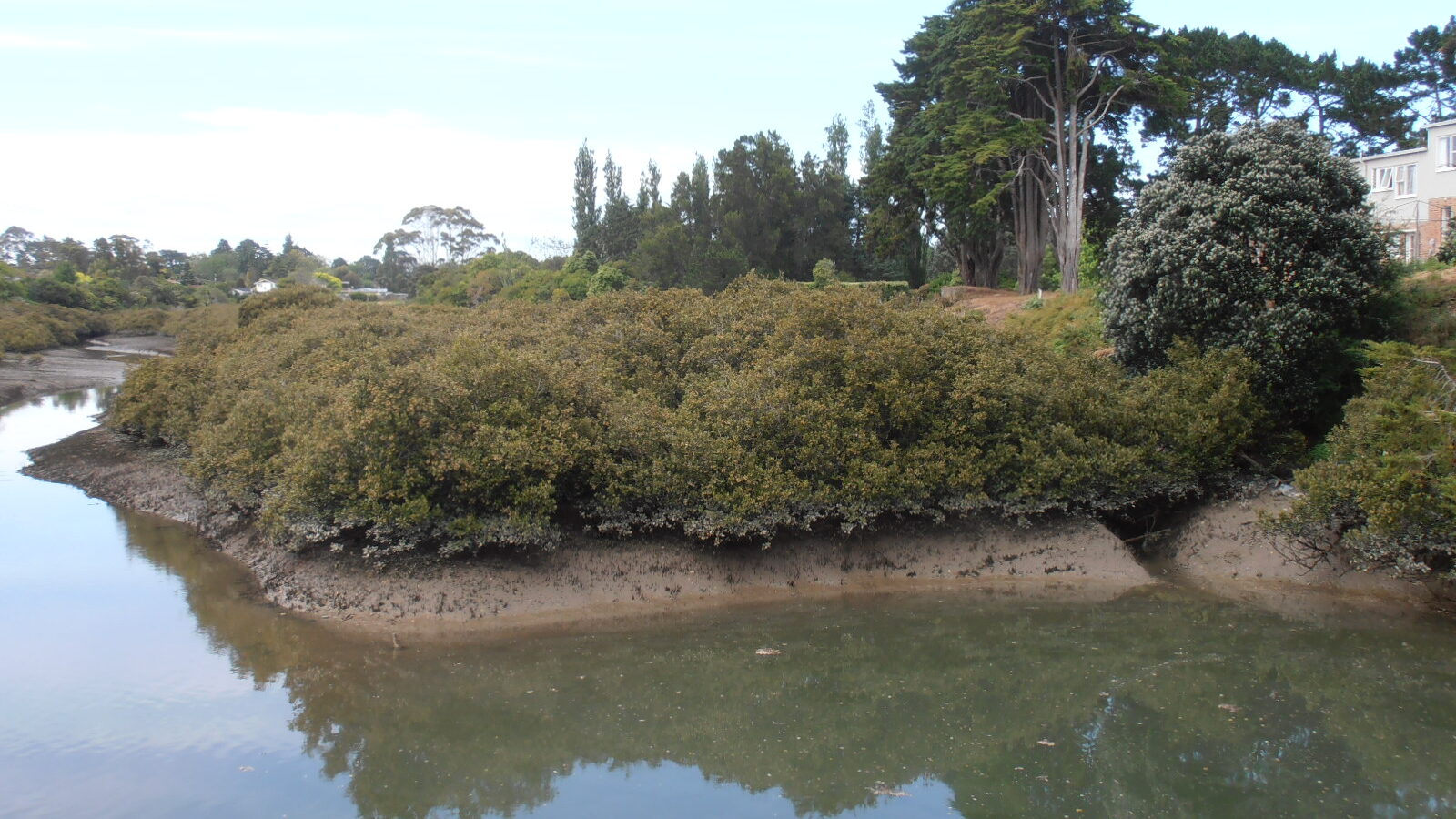
Researchers from the Auckland University of Technology recently took up the mangrove challenge and used a variety of monitoring techniques to reveal the secret life of urban mangroves. The results of their study have just been published in the international research journal, Ocean and Coastal Management.
Aotearoa/New Zealand has just the one species of mangrove – the grey mangrove (Avicennia marina subsp. australasica). It’s been here for over 11,000 years and is the most southerly mangrove in the world. Unlike many other native species, mangroves have responded enthusiastically to man-made changes to their surroundings.
“Expansion of mangroves has occurred rapidly over the past century due to increased sedimentation linked to land-use changes, such as agriculture, industrialisation and urbanisation of coastal areas. This growth has led to the infilling of estuaries and subsequent resource consents lodged for the removal of large areas.”
That expansion has made mangroves unpopular – but are they just underappreciated and poorly understood?
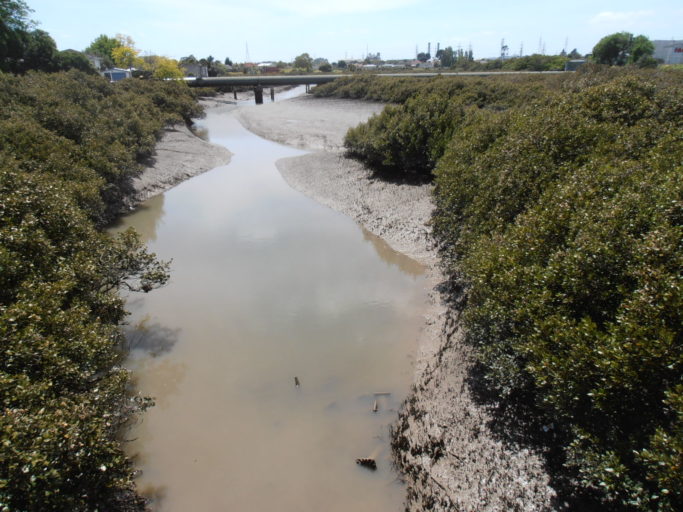
“Expansion of mangroves has created a myriad of social-ecological issues regarding amenity value and cultural access of waterways for local communities and the potential impacts of mangrove forest expansion on New Zealand animal biodiversity and surrounding coastal landscapes. As a result, there have been many applications submitted to regional councils for removal of large areas of mangroves. However, the impacts of removal of this indigenous ecosystem are not yet well understood and there are significant knowledge gaps.”
Compared to tropical mangrove ecosystems, our temperate mangroves are less biodiverse. Most attention has been paid to the macrobenthic organisms – creatures large enough to be seen with the naked eye which live at the bottom of waterways. But land creatures live in mangroves too.
“There are no unique estuarine or marine organisms in temperate mangroves. In the temperate mangroves of New Zealand, there has been a strong effort to quantify macrobenthic invertebrate community compositional change following mangrove establishment and subsequent removal. However, there is a lack of long-term monitoring of other groups of organisms, particularly terrestrial vertebrate and invertebrate species. There has been one study in New Zealand documenting the use of mangrove by terrestrial invertebrate biodiversity. This study showed that mangroves support a diverse range of terrestrial arthropod species, almost half of which have not been found in inland habitats.”
So what does live in the mangroves – and how can they best be detected and monitored?
“Mangroves are notoriously difficult habitats for fieldwork and capturing biodiversity within them requires techniques and equipment little trialled in ecological research. A review paper of studies in New Zealand mangroves highlighted the gaps in knowledge around insects and spiders, reptiles, mammals, fish and birds in mangroves. Thus, the present study aims to provide baseline biodiversity data of species that utilise mangrove habitats in New Zealand.”
The researchers aimed to use as many non-invasive methods as possible and for their methods to be easily replicated by future citizen science monitoring projects. The objectives of the study were:
- To successfully capture biodiversity information in mangrove habitats over a short-term period (1 week per site, 4 sites);
- To investigate community patterns of abundance and diversity of terrestrial arboreal invertebrates within and between sites and how these relate to mangrove habitat complexity parameters;
- To investigate how connectivity of mangrove habitats affects arthropod biodiversity of the plots sampled;
- To investigate what kinds of organisms are trapped or recorded in different trap types.
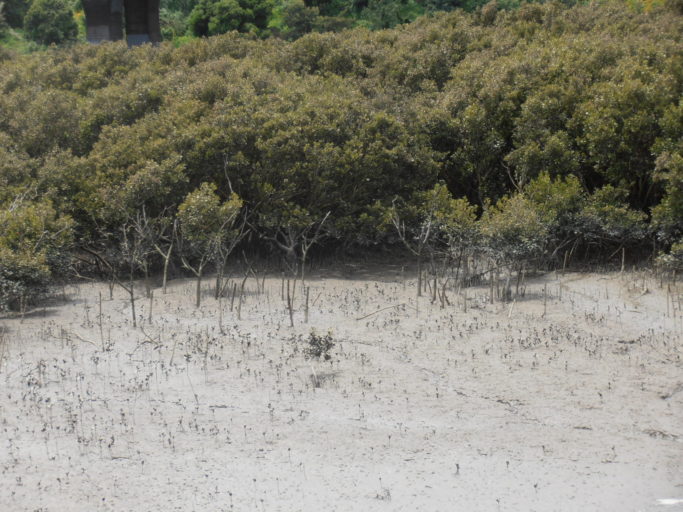
“The study sites were four mangrove stands (Pahurehure inlet 2, Waimahia, Puhinui and Mangere inlets) within the Manukau Harbour. The Manukau Harbour is New Zealand’s second largest harbour, with a surface water area of 394 square kilometres and tidal range of up to 4 metres. The harbour has undergone 10 million years of sedimentation, which has continued since the diversion of the Waikato river to the Tasman Sea from the collection of many small rivers and streams, creating a shallow harbour, with shifting sandbars, widespread mudflats and fringing mangroves. The harbour was a prevalent historical waterway for Maori and is popular for recreational activities, such as fishing and boating.”
These sites are considered to be ‘disturbed’, due to the large amount of alteration of the mangroves and surrounding environment through coastal development and urbanisation. Disturbance reduces biodiversity and impairs ecosystem function.
“This study aimed to provide baseline biodiversity data for a wide range of species in disturbed mangrove sites, using habitat complexity parameters such as canopy cover, above ground biomass and height of mangrove trees as proxies for degradation. In addition, this study provided a snap-shot of biodiversity during a late austral summer.”
The following non-invasive capture techniques were trialled for the various animal groups, to provide baseline biodiversity data:
- Arboreal arthropods were caught and collected at each sites (five adult trees per plot) by means of a beat sheet and sweep net. Foam covers used to trap reptiles were also expected to trap insects since they were wrapped around the five adult trees in each plot.
- Tracking tunnels were placed on the ground in each plot (one per plot, attached to a tree trunk), with an ink pad baited with a small piece of banana to assess whether reptiles were present.
- Holden traps were baited with a smear of peanut butter and tied to an adult tree in each plot, some distance away from the tracking tunnel baited station, in order to assess mammal presence. After the capture of a mammal in a trap, the trap was removed as this was to detect presence, absence only.
- Bat surveys with a Magenta Bat 5 heterodyne bat detector were conducted from dusk until nightfall at all sites along the terrestrial edges of each site.
- To monitor fish, two Hero-5 go-pro’s in water-proof housing were placed during tidal inundation at the seaward edges of each site (over 50 m apart within the mangrove habitats). Each go-pro was tied to a metre long stick, with fish bait attached to the stick in front. Footage was recorded during high tide.
- Timed bird surveys of 10 min were carried out in each plot over the time period of five to seven days. Species, relative abundance, behaviour, date, air temperature and location were recorded. Dusk surveys were also conducted at each site over the course of one to 2 h from a vantage point which covered all plots at each site.
- Four trail cameras were placed within each site (two on seaward edges, one in the centre and one on the terrestrial edge). No particular group of organisms were targeted here. Cameras were attached above the tidal mark to adult trees.
“The greatest agb (above ground biomass), mean canopy cover and mean density of adult trees was found at Mangere. The highest adult trees, mean crown leaf spread and the lowest canopy cover and density of adult trees were found at Waimahia mangroves. The lowest agb was seen at Pahurehure inlet 2. The highest abundance of saplings was found at Pahurehure inlet 2 and the highest mean seedling abundance and leaf litter was found at Puhinui mangroves. The highest mean abundance of pneumatophores was found at Waimahia. Mangere mangrove had the lowest abundance of saplings and percentage leaf litter, with Pahurehure inlet 2 having the lowest mean seedlings. Puhinui mangroves had the lowest amount of pneumatophores.”
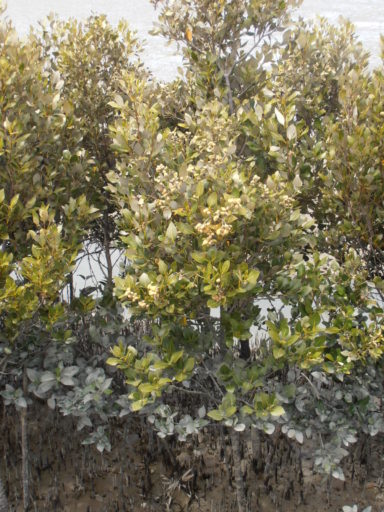
“A total of forty-nine species of arboreal arthropods, fifteen bird species, six mammalian species, two fish species, two crab species, one shrimp species, one gastropod snail species, one jellyfish species and one amphipod species were recorded in mangrove habitats at four sites in the Manukau Harbour (collectively). As this was a snap-shot, short-term study in late summer, other species which occur at other times of the year may have been missed.”
Spiders, beetles, ants and woodlice were commonly seen.
“Arboreal arthropods consisted of four classes: Insecta, Arachnida, Malostraca and Diplopoda with a total of 10 orders, 49 species and 2699 individuals caught through sweep net, beat sheet and foam cover techniques. Visual observations at plots of flying insects which were unable to be caught easily were also recorded and included in this data set. The most diverse order of arthropods collected were the spiders, with 15 different species from 8 different families, followed by the beetles, with 12 different species from 7 families. The most abundant species across all sites was the ant Technomyrmex jocosus, followed by the common woodlouse.”
“No reptiles were observed within mangrove sites during this study from the foam covers or onduline tile trapping techniques. Skink (unidentified species) were observed at the marsh edge bordering the mangrove at all sites.”
Rats, mice and other mammals were also detected.
“Mammals were detected at all sites except Mangere mangrove. Holden traps caught Norway rats in seven traps (19.4%), three of which were at Waimahia mangrove. The tracking tunnels picked up both rat and mice prints in 25% of tunnels over the fieldwork period. Mice were detected at Puhinui only. Two bat passes were recorded at Pahurehure Inlet 2. A domesticated cat, hedgehog and possum were also detected on the edges of the mangrove at Waimahia.”
Go-pro data recorded two fish species the yellow eyed mullet and the short-finned eel, along with mysid shrimp and two crab species.
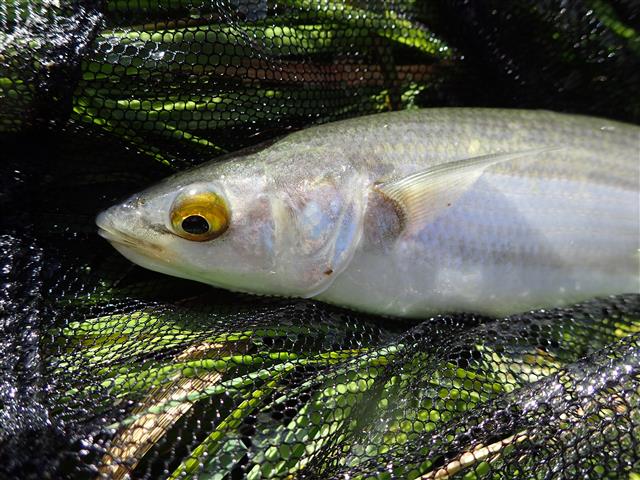
“Waimahia mangrove had the greatest abundance of juvenile yelloweyed mullet present throughout the video footage. It also had the highest abundance of short-finned eels. A permanent channel was found at Waimahia which contained a resident short-finned eel population of approximately five eels per metre squared for a length of 20 m (abundance estimated at low tide). No eels were detected at this site in the go-pro footage. Mangere mangrove had the greatest number of mysid shrimp. Puhinui mangrove had the least abundance of species.”
A total of 619 birds were recorded at all sites over the period of observation. The highest abundance was recorded at Pahurehure inlet 2, with a total of 445 birds observed over a one week period, the fewest birds were observed at Waimahia (39 birds). The greatest species richness was observed at both Pahurehure inlet 2 and Puhinui.
An introduced bird, the greenfinch, was the most abundant, with 322 individuals observed at Pahurehure inlet 2. Fantails and blackbirds were present at all sites.
“The trail camera data photographed eight different species of bird, including the threatened native species the Banded Rail, present at both Pahurehure inlet 2 and Waimahia mangrove. The camara also recorded the Norway rat and jellyfish.”
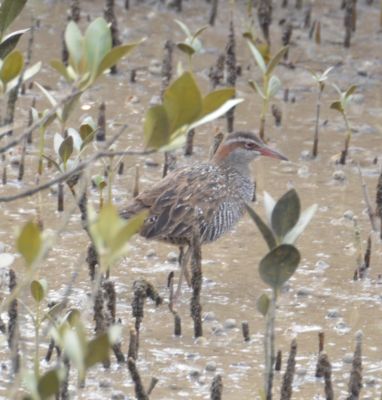
Although the same species of mangrove was growing at all sites, not all mangroves were the same.
“Even though the sites are composed of the same species of mangrove, the results highlight that there is much architectural heterogeneity among patches in terms of tree characteristics. Mangere mangrove stands had the greatest mean agb (above ground biomass), canopy cover and density of adult trees and the least saplings and leaf litter. This mangrove site also has the largest connecting area of mangrove out of all the four sites. Pahurehure inlet 2 had the lowest agb and the highest mean sapling abundance, and this was the least connected mangrove habitat. Waimahia mangrove had the largest mean crown spread, the highest trees and the most pneumatophores, whilst Puhinui mangrove had the highest mean seedling abundance and leaf litter, with the least number of pneumatophores.”
The detection of bats was particularly interesting.
“Pahurehure inlet 2 had two bat passes possibly belonging to the native long tailed bat. It is advised that further monitoring be carried out with special regard for mammalian monitoring. The Banded Rail is a threatened native species of bird in New Zealand, and has been recorded utilising the edges of mangroves before. In this study, the trail cameras picked up the species foraging in the centre of the mangrove (Waimahia). This provides strong evidence that rails also utilise the interior of mangrove stands for shelter and foraging, not just the edges.”
Overall, the study showed that a wide-range of both native and non-native species occur at these mangrove sites.
“This calls into question the perceived biodiversity value of mangrove ecosystems in New Zealand and reasons driving applications for removal. The terrestrial component of mangroves is often overlooked. This study has shown that arboreal insects and spiders make up a substantial part of mangrove biodiversity. The coastal ecology of the area should be considered, with connectivity between habitats and utilisation of coastal ecosystems as whole, before decisions for removal of native habitats occur.”
The full articles is published in the journal Ocean and Coastal Management.

